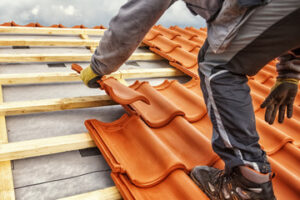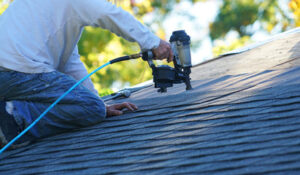Roofing is any construction, reconstruction, alteration, repair or maintenance to roofs to seal and water proof them. It also includes the installation of materials that prevent moisture intrusion into interior spaces such as chimneys and vents.

Before you begin any work on your roof, check with your city’s offices to make sure you have all the necessary permits. Also, lay down some large tarps to protect plants and catch the thousands of nails that will fall off as you remove the old shingles. Visit https://www.portcharlotteroofers.com/ to learn more.
Roofing is one of the most important building components in protecting a structure from moisture, sun exposure and other elements. Updating a roof provides an opportunity for impactful changes that can enhance a home’s curb appeal while increasing its value.
Choosing the right roofing material is an important step in completing a new roof installation or replacing an existing one. Today’s homeowners are offered a wide range of choices that provide different looks and features, as well as performance capabilities.
Asphalt composition shingles are a popular choice for many homeowners due to their blend of affordability, resilience and color options. They are composed of organic or fiberglass materials saturated in asphalt, then coated with ceramic granules that add texture and reflect sunlight to reduce a roof’s heating effect.
Rubber slates are another common option for flat or low-slope roofs. These are made from recycled materials, such as shredded tire tyres, EPDM or rubber and are highly durable with an expected life of 50 years.
Other roofing materials include metals, which have become increasingly popular as they are aesthetically pleasing and offer durability and longevity. These materials are also lightweight and can be installed over older roofs with ease.
Slate and wood are traditional roofing materials that provide a classic look. These are a good choice for high-wind areas, but require specialized framing and are more expensive than other roofing materials. They are long-lived, with some examples of slate roofs that have been in service for hundreds of years. Other roofing options include concrete tiles, which are made from natural materials and baked at high temperatures and come in a variety of colours. They are lighter than clay tiles but have the same durability.
Underlayment
Roof-covering materials typically require a waterproof or water-resistant barrier, or underlayment, to be installed over it. Depending on the type of underlayment used, this layer helps to protect against things like physical damage during installation or severe weather conditions that might cause leaks. It also provides insulation and temperature regulation and bolsters the structural integrity of your roof. Understanding underlayment options, like asphalt-saturated felt, synthetic materials and rubberized asphalt, empowers homeowners to make the right choice for their roofing project.
Typically, a contractor will start by installing the first row of underlayment at the eaves or lowest point on your roof. They’ll overlap this row with the next by about two to six inches, following the manufacturer’s instructions for a tight seal that prevents water leaks. This pattern of overlapping rows and fastening with cap nails will continue up to the ridge line.
When it comes to underlayment, most professional contractors will favor a synthetic option. Synthetic underlayment has a base that’s saturated with asphalt, and it may also have an additional layer of fiberglass for added durability. This material is highly flexible, resistant to tears and UV rays, and helps your roof breathe better than felt paper. Additionally, most synthetic underlayment is designed with a non-slip surface for safety, and it features printed marks that help roofers line up rows properly.
Alternatively, some roofers may choose to work with a self-adhering membrane underlayment. This product is easy to use, and it features a sticky layer that adheres to the roof deck. It’s a great choice for areas of the roof where water tends to collect or for protecting against ice dams in cold climates. It’s not as breathable as felt underlayment, but it can be more affordable than other types of underlayment.
Flashing
The purpose of flashing is to prevent water from seeping into areas that are prone to leaks, such as the edges of a roof or the protrusions of chimneys and vent pipes. Roofing professionals use flashing in various shapes and sizes to help waterproof these areas and prevent seepage that can lead to structural damage or mold.
The first type of flashing is base flashing, which sits at the point where a flat roof plane meets a vertical wall. It protects the vulnerable crease and also helps to guide water into gutters. Base flashing is often a long piece that runs across the entire roof, but it can warp or deteriorate over time, which means it needs to be properly sealed in order to prevent water damage.
Homeowners may also need step flashing, which is used around penetrations in the roof, such as plumbing vents or skylights. This flashing consists of multiple pieces of sheet metal bent into an L-shape. These pieces overlap like fish scales to create a protective barrier against water. When shingles are installed on the roof, they should be placed over this flashing and secured with cement to ensure that it remains in place.
Alternatively, homeowners can choose to install a custom piece of step flashing for the peak of their roof. To do this, they need to cut a usual piece of step flashing into its fold about halfway. Then, they can bend the other side to match the shape of the roof’s peak. They can then cover the new piece with a shingle, which should be secured with roofing cement as well.
Other types of flashing include pipe boot flashing, which is cylindrical and fits right over a vent or pipe. Kickout flashing is also a popular choice for the point where the step flashing ends and the gutter begins. It’s shaped kind of like a scoop to help direct water away from the wall and into the gutter.
Shingles
Shingles come in a variety of colors, sizes and styles. They are designed to offer excellent weather resistance and withstand high winds. They are also designed to provide insulation for your home. They are often manufactured with a fire rating which is important for areas that experience wildfires or other external fire hazards.
Before shingles are installed, the roof needs to be prepped. This is done by laying the underlayment down and nailing it in place. Then, it is time to start installing the shingles! Start at the drip edge, then work your way up the roof. Each row should overlap the last by about 4 inches. Be sure to install flashing around any chimneys and other valleys where two roof planes meet. This is usually metal flashing, which is laid over tar, and then the upper shingles are interlaced with it. Chimneys, vents and stack pipes are surrounded by flashing as well.
The first row of shingles is called the starter strip and should overhang the drip edge by about half an inch. Next, install the shingle course that will go all the way to the ridge. Start by mapping out a guideline with chalk on the roof. Then, snap a line vertically every 5 inches. This will help you stay straight as you continue to shingle your roof.
When putting down the second course, be sure to offset each shingle by 1/2 tab from the shingles below. This will give the shingles a better chance to “butt” against each other horizontally. Each shingle has little cuts on its sides that you will need to bend up, which provides a reference point for butting. Hammer a nail about 1 inch above each cut on the shingle to hold it in place.
Tiles
A tile is a flat piece of unglazed fired clay or concrete that creates a wall or roof surface. Tiles are available in many different colors and shapes, so it is possible to create a design that matches almost any home décor. They can also be made to mimic the appearance of other materials, such as stone, wood and concrete.
Unlike shingles, tiles are fastened with mortar, instead of adhesives or other liquid sealants. This method of installation increases the strength of a roof and helps prevent leaks. Depending on the type of tile and roof construction, fasteners can be nails, clips, wire, foam, caulk or grouting mortar. The tiles are laid in a grid pattern, usually starting at the center and working outwards from there. To ensure proper alignment and even spacing, the installer may mark a grid on the floor or ceiling with a ruler or tape.
In addition to enhancing a home’s architectural integrity, tile roofing is naturally resistant to moisture and the elements that degrade other roofing materials. This durable roof can provide years of protection for a house and its occupants.
A metal drip edge is installed at the edge of a roof to direct water flow away from tiles and preserve them longer. It is often bent or cut to fit around a dormer or other roof feature. The edges of the roof are secured with roofing nails to form a protective barrier from the weather.
Since a tile roof is heavier than other roofing materials, it may require additional structural support to prevent damage or failure. A professional roofing contractor will be able to assess the integrity of a home and recommend any necessary structural modifications prior to installing a tile roof.
